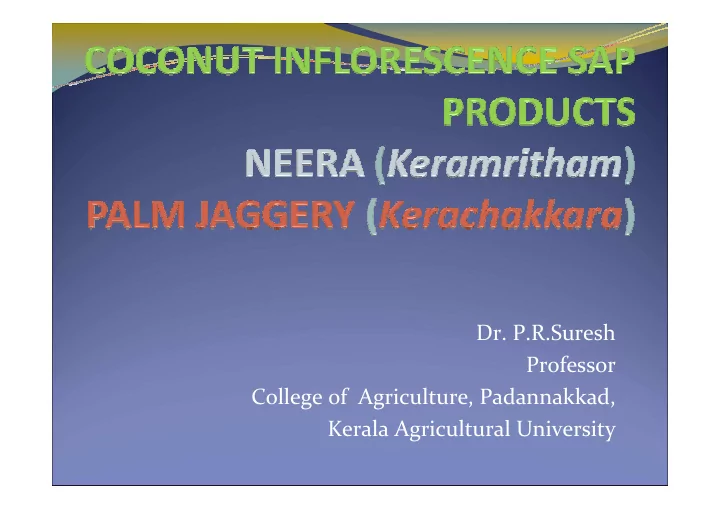

Dr. P.R.Suresh Professor College of Agriculture, Padannakkad, Kerala Agricultural University
COLLEGE OF AGRICULTURE PADANNAKKAD KERALA AGRICULTURAL UNIVERSITY E-mail :coapad@kau.in Website: www.kaupad.edu.in
IMPORTANCE OF COCONUT India – 3 rd largest producer Total production - 15,730 million nuts from nearly 1.9 mha -(C DB 2007) The productivity of the crop is highest in India with 8303 nuts/ha. Four states contribute - 92% of production 1. (Kerala (45.2%), 2.Tamil Nadu (26.6%), 3. Karnataka (10.8%) 4. Andhra Pradesh (8.9%)) and 5. other states contribute 8%.
� Kalpa vrisha of kerala � MEETS FOOD AND HOUSING FOR MANY PEOPLE � CULTIVATED OVER 93 NATIONS � CAN MAKE MORE THAN 300 PRODUCT � AS A FOOD ITEM PROVIDE ENERY, PROTEINS FAT DIETARY FIBRE,VITAMINS AND MINERALS
� Cultivated over 7.7 lakh ha � Small and marginal farmers � Low price of produce � Pest and disease problems � Farmers move away from coconut sector � Thrives on oil based products
Prospects of Coconut inflorescence sap and its products � Coconut used for culinary purpose (30%) and 70% for copra(85% oil & 15% ball copra) � Only 2% for tender nut water � Pressure from cheaper oil sources like Palm oil and sunflower oil � Rich source of Lauric acid and myristic acid - Premium price – industrial use- availability of substitutes � Sustainability of coconut sector – through value addition, product diversification, improving farm level processing, increasing byproduct utilization
Task force/ technical committee: � Dr. B. Jayaprakash Naik. Associate Director of Research, Coconut Mission � Dr. P.R. Suresh, Professor, CoA, Padannakkad � Dr. P.C. Balakrishnan, Associate Director, Rtd � Dr. Madhu Subramanian, Assistant Professor, COH, Vellanikkara � Dr. Meera Manjusha, Assistant Professor, RARS Pilicode
Prospects - inflorescence sap and its products � Rich in Vit c and phenols decelerates aging � Rich in K and low in Na pr helps in fluid balance � Rich in sugar Ferments fast and forms toddy (8% alcohol) � Storing as unfermented neera – a challenge � Tender nut water yield is low : appro. 2 L/bunch where as inflo sap yield is 60 – 75L � Daily production � More economical and remunerative than tender nut
BRIEF HISTORY � Practice of toddy tapping is as old as coconut cultivation � Very popular among ethnic communities � Preferred beverage and sugar source in islands � In Kerala the practice is supposed to came from Sree Lanka � Mentions made as energy rich relaxing beverage � Very popular in coastal Kerala
Production of Neera ( Keramritham ) from Coconut inflorescence sap Extraction of sap from the inflorescence by indigenous methods ↓ Sap flow during the over night period collected in clean and hot water washed specially made earthen pots (mattoms) in a slaked lime solution ↓ Collection of the overnight sap from the palms in early morning hours ↓ Bulking the sap collected from different palms ↓ Refrigeration ↓ contd…
Contd….. ↓ Centrifuging/ sedimentation ↓ Addition of class II preservatives and dilution to desirable concentration/strength ↓ Transferring to clean bottles ↓ Carbonation ↓ Sealing ↓ Storing under refrigeration ↓ Serve chilled
Tapping needs lots of technical skill
pH stabilization
Centrifuging
QUALITY ASSURANCE
FILTRATION AND CARBONATION
KEERAMRUTHAM IN PURE FORM
Keramritham
KEERAMRUTHAM
Nutritional qualities of Neera � Total sugar : 18 - 20% � Vitamin C : 1.3mg/100ml � pH : 6.8 � Acidity : 10.0 m eq/l � Phenols : 8.0mg/100ml � Minerals K : 90.5ppm Ca : 60.0ppm P : 15.0ppm Fe : 45.0ppm Na : 9.5ppm
Prospects � Can be promoted as a Health drink : Constituents Neera Tender nut water Total sugar 18 - 20% 3.3% Vitamin C 1.3mg/100ml pH 6.8 4.7 Acidity 10.0 m eq/l : Phenols 8.0mg/100ml Minerals K 90.5ppm 53.2ppm Ca 60.0ppm 5.78ppm P 15.0ppm 11.8ppm Fe 45.0ppm 1.54ppm Na 9.5ppm
Returns Number of palms tapped by a taper a day 12 palms Sap yield/day(Average 1.5L/palm/day 12X15=18 litres Sap yield/month 18X30=540 litres Quantity of sap used for making soft drinks(2/3 of the 540X2/3=360 total volume) litres Quantity of sap after processing (Recovery 75%) 350 litres Volume of sap/bottle 250ml Total number of bottles 1400 Monthly income (Rs.25/bottle) 35,000 Expenses 23000 Profit 12000 Income from single palm: Rs.1000/month
Preparation of Palm jaggery ( Kerachakkara ) From coconut inflorescence sap Extraction sap from coconut inflorescence by indigenous methods ↓ Collection of overnight sap flow in specially made clean earthen vessels (Mattoms) in a medium of slaked lime solution ↓ Collection of sap from the palms during the early morning hours ↓ Bulking ↓ Concentrating in open pan over fire ↓ Transferring to the solidifying trays ↓ Packing and Storing in air tight containers
Palm sugar/ ghur
Palm jaggery
Vital links � Farmers � Tapping technicians � Technology � Food processing industry � Marketing
Recommend
More recommend